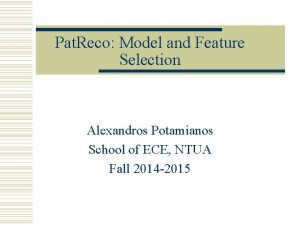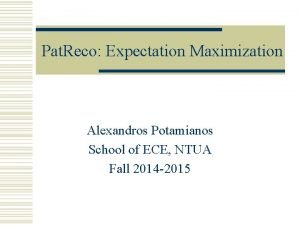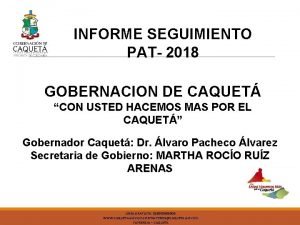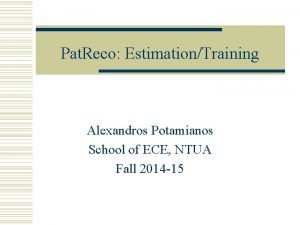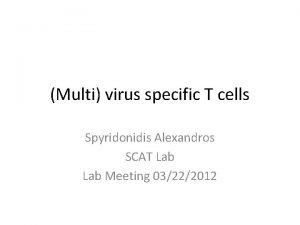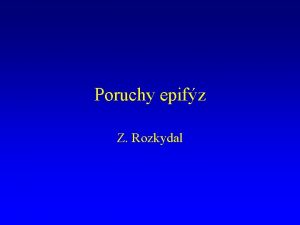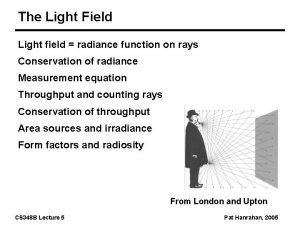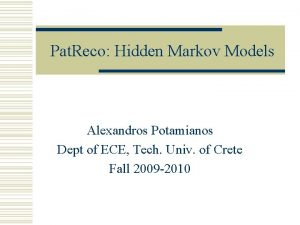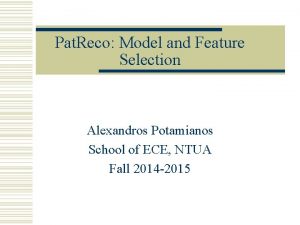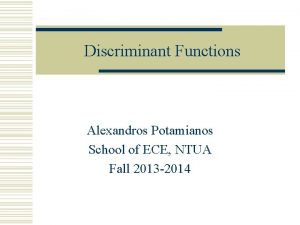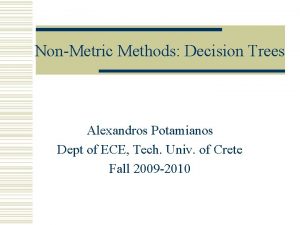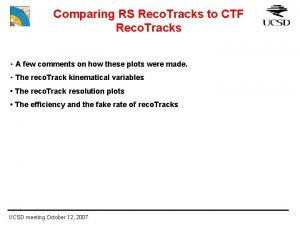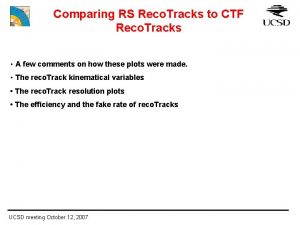Pat Reco EstimationTraining Alexandros Potamianos School of ECE















- Slides: 15

Pat. Reco: Estimation/Training Alexandros Potamianos School of ECE, NTUA Fall 2014 -15

Estimation/Training w Goal: Given observed data (re-)estimate the parameters of the model e. g. , for a Gaussian model estimate the mean and variance for each class

Supervised-Unsupervised w Supervised training: All data has been (manually) labeled, i. e. , assigned to classes w Unsupervised training: Data is not assigned a class label

Observable data w Fully observed data: all information necessary for training is available (features, class labels etc. ) w Partially observed data: some of the features or some of the class labels are missing

Supervised Training (fully observable data) w Maximum likelihood estimation (ML) w Maximum a posteriori estimation (MAP) w Bayesian estimation (BE)

Training process w Collected data used for training consists of the following examples D = {x 1, x 2, … x. N} w Step 1: Label each example with the corresponding class label ω1, ω2, . . . ωΚ w Step 2: For each of the classes separately estimate the model parameters using ML, MAP, BE and the corresponding training examples D 1, D 2. . DK

Training Process: Step 1 D = {x 1, x 2, x 3, x 4, x 5, … x. N} Label manually ω1, ω2, . . . ωΚ D 1 = {x 11, x 12, x 13, … x 1 N 1} D 2 = {x 21, x 22, x 23, … x 2 N 2} ………… DK = {x. K 1, x. K 2, x. K 3, … x. KNk}

Training Process: Step 2 w Maximum Likelihood θ 1 = argmaxΘ P(D 1|θ 1) w Maximum-a-posteriori θ 1 = argmaxΘ P(D 1|θ 1) P(θ 1) w Bayesian estimation P (x|D 1) = P(x|θ 1)P(θ 1|D 1) dθ 1

ML Estimation Assumptions 1. P(x|ωi) follows a parametric distribution with parameters θ 2. Dj tells us nothing about P(x|ωi) (functional independence) 3. Observations x 1, x 2, x 3, … x. N are iid (independent identically distributed 4 a (ML only!) θ is a quantity whose value is fixed but unknown

ML estimation θ = argmaxΘ P(θ|D) = argmaxΘ P(D|θ) P(θ) =4 argmaxΘ P(D|θ) = argmaxΘ P(x 1, x 2, … x. N |θ) =3 argmaxΘ Πj P(xj|θ) => Πj P(xj|θ) / θ = 0 => θ = …


Bayesian Estimat. Assumptions 1. P(x|ωi) follows a parametric distribution with parameters θ 2. Dj tells us nothing about P(x|ωi) (functional independence) 3. Observations x 1, x 2, x 3, … x. N are iid (independent identically distributed) 4 b (MAP, BE) θ is a random variable whose prior distribution p(θ) is known

Bayesian Estimation P (x|D) = P(x, θ|D) dθ = P(x|θ, D)P(θ|D) dθ = P(x|θ)P(θ|D) dθ STEP 1: P(θ) P(θ|D) = P(D|θ)P(θ)/P(D) STEP 2: P(x|θ) P (x|D)

Bayesian Estimate for Gaussian pdf and priors If P(x|θ) = Ν(μ, σ2) and p(θ) = Ν(μ 0, σ02) then STEP 1: P(θ|D)=Ν(μn, σn 2) STEP 2: P(x|D)=N(μn, σ2+σn 2 ) μn = σ 2 /(n σ 2 + σ2) (Σj xj) + σ2 /(n σ 2 + σ2) μ 0 0 σn 2 = σ2 σ02 /(n σ02 + σ2) For large n (number of training samples) maximum likelihood and Bayesian estimation equivalent!!!

Conclusions w Maximum likelihood estimation is simple and gives good estimates when the number of training samples is large w Bayesian adaptation gives good estimates even for small amounts of training data provided that a good prior is selected w Bayesian adaptation is hard and often does not have a closed form solution (in which case try: iterative recursive Bayesian estimation)
 Alexandros potamianos
Alexandros potamianos Alexandros potamianos
Alexandros potamianos Reco reco portugal
Reco reco portugal Pat pat seguimiento
Pat pat seguimiento Potamianos ntua
Potamianos ntua Alexandros spyridonidis
Alexandros spyridonidis Reco cement
Reco cement Oracle mman
Oracle mman Reco condusef
Reco condusef Dlaha atlanta
Dlaha atlanta Complete the text. write one word in each space
Complete the text. write one word in each space Pat oliphant cartoon archive
Pat oliphant cartoon archive Phonetically definition
Phonetically definition Pat coso
Pat coso Princess pat lyrics
Princess pat lyrics Same song pat mora
Same song pat mora
